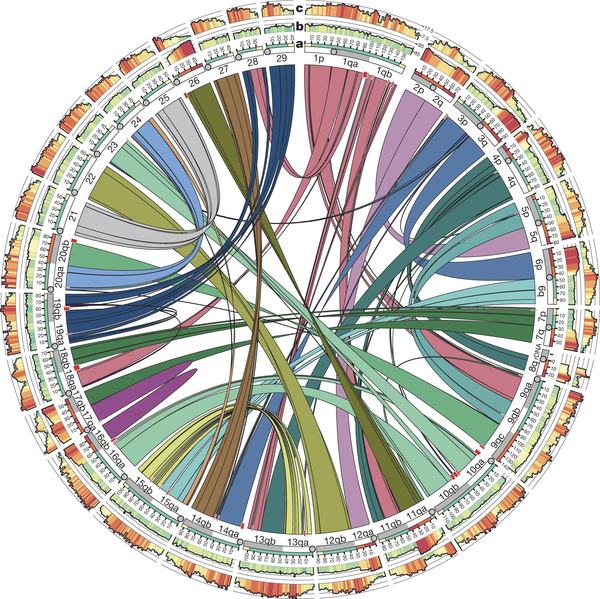Alongside scientists of four countries, assembled one of the most complex genomes ever decoded. The results of the research published in the prestigious journal gives relevant information for the development of the aquatic industry.
A group of researchers at the Center for Mathematical Modeling (CMM) and from the center for Genome Regulation (CRG) of Universidad de Chile participated in a collaborative research on the Atlantic salmon genome which was published on Monday the 18th of April in Nature Journal (http://www.nature.com/nature/journal/vaop/ncurrent/full/nature17164.html)
Alejandro Maass and Alex di Genova were part of the international partnership for the Sequencing of the Atlantic Salmon Genome, formed by Chilean, Norwegian, American and Canadian scientists, that had already given results in 2014, by publishing the integral sequencing of this fish. The information published now is as or even more relevant, because it analyses the genome, its characteristics and particularities, what translates in relevant information for the development of new technologies and products that will go in direct benefit to the industry.
In the scientific field, this new work realize significant findings. Contrary to many terrestrial vertebrate species, the Atlantic salmon genome presents an important and defiant characteristic: duplication. In other words, it has two versions of each functional and non-functional gene in its genome, product of the duplication produced since millions of years back.
This work contradicts the classical hypothesis that affirms the impossibility of sustaining over time two copies or versions of genes in a genome. The key being, that the duplicated copies weren’t lost in time, but adopted new functions instead. This allowed the Atlantic salmon to adapt and generate new functions. Consequently, this genome represents a new and relevant paradigm and information for comparative genomics studies and for the understanding of the process of genomic evolution in other fish species.
Bioinformatics expertise
In the research, scientists and public and private institutions of the four members of the partnership were involved. Chile participated through the Economic Development Agency (Corfo) which called Alejandro Maass as scientific assessor. He, Patricia Iturra (Faculty of Medicine of Universidad de Chile) and Rodrigo Vidal (Universidad de Santiago), formed the Chilean scientific committee of the study.
“Our contribution and expertise were in the area of bioinformatics, area that plays a crucial role in projects of assembly of high complexity organisms», states Maass.
“We used all the available algorithms to decipher the salmon», remembers Di Genova. In total, the partnership used ten strategies to solve the assembly of the fish. One of them was developed in Chile, where Bruijn graphs and the All-Paths assembly method were used.
“This was possible thanks to the calculus capacity of the Mathomics laboratory; in other words, we took advantage of our bioinformatics experience, developed and overhauled during almost ten years of work at the CMM and the CRG”, explains Maass, director of Mathomics.
Also joined the research the team of James Yorke, mathematician at University of Maryland and member of the scientific committee of the Centre for Mathematical Modeling. His work in a new strategy for assembling complex genomes, introducing the method denominated MASURCA problematic ideas coming from symbolic dynamics, was key to finish the task of decoding the Atlantic salmon.
The partnership generated eleven versions in total. Two of them were created at the CMM and CRG, says Di Genova: “The final is a mix of the one we made, the ones the JCVI made and the one that made the group from Maryland, plus the genetic map contributed by the Norwegian”.
With the published results in 2014 and the information disclosed today, high end technology will be possible to be developed in the development of vaccines and sanitary products, genetic selection plans and development and validation of new formulas or food products for the third export sector in Chile, that ships more than 800 thousand tons a year- equivalent to US$ 4,3 thousand millions 2015– and employs almost 60 thousand people.
Meanwhile, for the Chilean researchers, new challenges open up in the assembly of complex genomes. American entities asked them already to work with the Chinook salmon, that is as difficult to decipher as the Atlantic one. In the same line, they collaborated with the group of researchers of AquaInnovo and the Faculty of Veterinary Sciences of Universidad de Chile in the creation of a chip of genotyping for the analysis of Chilean salmon families. This technology allows to genetically select the fish to improve their offspring, what was done before using traditional genetics. This are only two of the challenges that will be tackled.
“In the Chilean genomes, of their people, flora and fauna that adapt to extreme conditions of all type, are hidden much of the secrets that have to do with the mechanisms nature use and, possibly, men to improve their lives», concludes Maass. “And if we Chileans do not investigate it, nobody will do for us».
Center for Mathematical Modeling
The CMM is the most active institution of scientific research on mathematical modeling in Latin America. Is a center of excellence of Conicyt, that functions at the Faculty of Physical and Mathematical Sciences of Universidad de Chile. Its mission is to create “new mathematics” to give answers to problems of other sciences, of the industrial sector and of public policies. In this sense, strives to respond to the necessities of areas such as mining, finances, transport, marketing, economy, education and health with the highest standards, excellence and thoroughness.
Source : CMM

